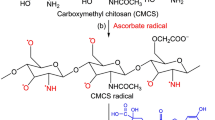Abstract
Chitosan is naturally occurring, biodegradable, non-toxic, non-allergenic biopolysaccharide derived from chitin which turns viscous upon dissolution in mildly acidic medium. Artificially changed chitosan consolidating hydroxyl chromone was set up by responding 6-Hydroxy-4-oxo-4H-chromone-3-carb-aldehyde with chitosan; it was found to have high specific and chelating proficiency towards transition metal ion at pH 1–8. Enhanced adsorption capacity and a strong affinity for Cu2+ was observed as compared to Cd2+, Ni2+ and Co2+ at pH 4–6. Chitosan-hydroxyl-chromone was chemically synthesized and characterized by spectroscopic techniques. Potentiometric strategies affirmed the request of selectivity which was free of the physical form of chitosan-hydroxyl-chromone subsidiary. 1H NMR outcomes recommended a level of substitution (DS) extending from 32.72 to 98.21%. Antimicrobial and antioxidant activity of chitosan-hydroxyl-chromone within the series of synthesized compounds was evaluated. To improve the solubility of chitosan in water, we present a synthesis of chitosan-based chromone biopolymers and its applications in metal extractions.







Similar content being viewed by others
REFERENCES
R. Bassi, S. O. Prasher, and B. K. Simpson, J. Environ. Sci. Health, Part A: Toxic/Hazard. Subst. Environ. Eng. 2, 289 (1999).
H. F. Mark, N. M. Bikales, C. G. Overberger, and G. Menges, Chemical Structure of Chitosan,in Encyclopedia of Polymer Science and Engineering (John Wiley and Sons, New York, 1985), Vol. 2.
R. A. A.Muzzarelli and R. Rocchetti, Talanta 21, 1137 (1974).
R. A. A. Muzzarelli, Chitin, Ability Chelate Ions of Transition Metals by Free Amine Function of Chitosan (Pergamon Press Ltd., New York, 1977), p. 140.
A. Bittel, Angew. Chem. 70, 638 (1958).
J. W. Mclaren, A. P. Mykyuik, S. N. Willie, and S. S. Berman, Anal. Chem. 57, 2097 (1985).
G. Persuad and F. F. Cantwell, Anal. Chem. (Washington, DC, U. S.) 64, 89 (1992).
G. Csanády, P. Narayanan, K. Müller, W. Wegscheider, and G. Knapp, Angew. Makromol. Chem. 170, 159 (1989).
E. P. Garduno Ruiz, L. Rosales Hoz, and A. Carranza Edwards, Bull. Environ. Contam. Toxicol. 97, 490 (2016).
V. Gurnani, A. Singh, and B. Venkataramani, Anal. Chim. Acta 485, 221 (2003).
A. Paulson, J. Anal. Chem. 58, 183 (1986).
K. Z. Perenyl, A. Lasztity, Z. S. Ilorvath, and A. Levai, Talanta 47, 673 (1998).
C. Fulcher, M. A. Crowell, R. Bayliss, K. B. Ilolland, and J. R. Jezorek, Anal. Chim. Acta 129, 29 (1981).
M. A. Marshall and I. A. Mottola, Anal. Chem. 55, 2089 (1983).
O. Zaporozhets, N. Petrruniock, O. Bessarabova, and V. Sukhan, Talanta 49, 899 (1999).
D. Y. Wu, L. X. Xie, C. L. Zhang, C. Y. Duan, Y. G. Zhao and Z. J. Guo, Dalton Trans. 29, 3528 (2006).
A. O. Martins, E. L. da Silva, E. Carasek, N. S. Gonçalves, M. C. M.Laranjeira, and V. T. Favere, Anal. Chim. Acta 521, 157 (2004).
A. J. Varma, S. V. Deshpande, and J. F. Kennedy, Carbohydr. Polym. 55, 77 (2004).
A. M. Ghatole, K. R. Lanjewar, and M. K. Gaidhane, World J. Pharm. Res. 3, 4336 (2014).
K. Kurita, T. Sannan, and Y. Iwakura, J. Appl. Polym. Sci. 23, 511 (1979).
M. Rhazi, J. Desbrieres, A. Tolaimate, M. Rinaudo, P. Vottero, and A. Alagui, Polymer 43, 1267 (2002).
G. J. Carpeni, J. Chim. Phys. 66, 327 (1969).
Z. Cao, H. Ge, and S. Lai, Eur. Polym. J. 37, 2141 (2001).
M. Rhazi, J. Desbrieses, A. Tolaimate, and M. Rinaudo, Eur. Polym. J. 38, 1523 (2002).
M. K. Gaidhane, A. M. Ghatole, and K. R. Lanjewar, Int. J. Pharm. Pharm. Sci. 5, 421 (2013).
ACKNOWLEDGMENTS
We express our sincere thanks to SAIF, Chandigarh for spectral analysis and also to NRPL Lab. Nagpur for evaluating antimicrobial activity and HOD, Department of Chemistry and Director, Institute of Science, Nagpur.
Author information
Authors and Affiliations
Corresponding author
Rights and permissions
About this article
Cite this article
Gaidhane, M.K., Ghatole, A.M. & Lanjewar, K.R. Synthesis of Chromone Functionalized Chitosan Polymer: Application/Screening of Its Physical Parameters. Polym. Sci. Ser. B 62, 206–217 (2020). https://doi.org/10.1134/S1560090420030045
Received:
Revised:
Accepted:
Published:
Issue Date:
DOI: https://doi.org/10.1134/S1560090420030045




